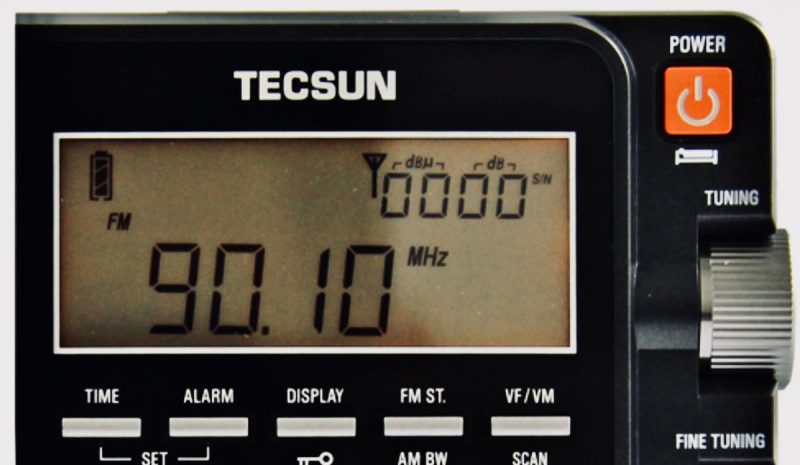Many thanks to SWLing Post contributor, Chris Rolfe (M3OZP), who writes with the following inquiry:
Don’t know if anyone can help.
I have a Tecsun PL-880, and it shows signal strength in db. How can I work out the signal strength as 1 to 5? All my other radio have 1 to 5 signal strength meters which is what I have always been used to.
Many thanks.
Chris Rolfe
M3OZP
Thank you for your question, Chris. The signal meter on the PL-880 and a number of other late-model Tecsuns that use similar DSP chips share the signal display which indicates both the signal strength and signal-to-noise ratio. I believe the dBu number indicates the conducted voltage across the receiver’s internal resistance.
It’s perhaps one of my quirks, but as a listener I actually pay little attention to signal displays on portables unless I’m evaluating signal strength for a report or even using it to locate a local noise. Converting those numbers into an S1 to S5 number is simply something I would do by “guesstimating.” Yeah, not terribly scientific.
There are folks in the SWLing Post community who can do a much better job explaining the readout and how to interpret/convert signal strength across the MW, SW and FM bands.
Post Readers: Please comment if you can shed some light on simplifying signal strength for Chris.


Thanks for bringing this up and the discussion that follows (especially the comments here and in the links folks have posted). Having retuned to SWL after many years (50) this is a topic that I have pondered quite a bit. When I listen to the Amateur bands and hear reports of “5 by 9” for just about everything, it is clear that this this is a very subjective judgement. Indeed, 50 years ago we all acknowledged this was completely subjective. One would think that after all this time the science behind signal strength would have improved. Judging from the comments, it looks like there have been some attempts at doing that. But at this point I am fairly convinced signal strength report are still, and will always be completely subjective.
To add to the confusion, I often wonder if the Hams making these reports are describing the “peaks” of the contact or the average signal strength. Who knows. But I think guys just like to hear that their rigs are working well.
The expression we used back in the day was, “You’re melting my antenna” and I still like that analogy. In actuality, with the advent of SDR and the proverbial “waterfall” display, I’m inclined to used the “sparkle factor” it determining s-strength. The more sparkles and colors rendered in the waterfall, the stronger the signal!
Thanks again and 73 to all.
J
The problem is that this is hard coded and deriving numbers rather than levels. If you were determined to do this you could add extra circuitry which would be accurate. You could attach an RSSI chip which converts dB levels to a linear output voltage and then feed that to a suitably calibrated bar driver display (such as LM3819) which would drive only 5 LEDs. RSSI chips were originally designed for analogue cell ‘phones to indicate the level at which cell switching might be needed (after considerable averaging). Latterly, the whole function has been embedded within SDR in ‘smart’ ‘phones – hence the number crunching. Surprisingly, the chips are still very readily available and I believe the 3819 goes back well into the 1970s! Given the circuit density inside the rx, you could build this as a base add-on and disconnect when going portable, at a push.
There’s at least 3 different “standards” for S-meter readings/sensitivity (a historic US ‘standard’, the later IARU R1 ‘standard’ 6dBuV/S-unit, and a Japanese ‘standard’ which I forget exactly but from memory has different dBuV steps across the scale). And that’s just for HF; VHF is different again.
On top of that, as per the Si4735 documentation the reference point for the Si4735’s level & SNR measurement is not the antenna input but the chip’s RF/IF input pins. So the measurements are dependent on preamp/IF gain/attenuation & noise.
So, not only are S-meters a relative not absolute reading, they’re different depending on the age and origin of the equipment and where in the chain is considered the ‘measurement point’. All that makes them useless for comparative readings across different radios unless you know how each measures it…
Radio Time Traveler did a post on Tecsun dBu units some time back:
http://radio-timetraveller.blogspot.com/2015/01/the-ultralight-db-mystery-s-meters-and.html
I have a Tecsun PL-390 and at the 2.0 millivolt/meter it reads 74 dbu
Maybe even before “s-meters” there was RST, Readability, Strength, and Tone. The last for the quality of a CW signal. I forget whether it was 1 to 5 or 10, but it was a judgement call, a relative interpretatiin of tye incoming signal.
S-Meters are generally nonsense. If you need to peak a preselector or antenna they will show the relative change. While some people talk about a standard, I forget the details, most consumer receivers have meters that just add flash. There is no standard and even if there was, nobody is hand calibrating the meter, and things like a bigger antenna will invalidate any calibration.
“S” units are relative strength, like that RST system. The scale runs out at 9 and then it tries be valid by adding “db” to the scale. The readings, if real, would be ridiculous
Interesting question and responses.
Good luck and happy space trails Perseverance rover!
John
(KC8RZM)
S-unit µV dBµV
———————
S9+60 50000.0 94
S9+50 15810.0 84
S9+40 5000.0 74
S9+30 1581.0 64
S9+20 500.0 54
S9+10 158.1 44
S9 50.0 34
S8 25.0 28
S7 12.5 22
S6 6.3 16
S5 3.2 10
S4 1.6 4
S3 0.8 -2
S2 0.4 -8
S1 0.2 -14
From this article:
https://radio-timetraveller.blogspot.com/2015/01/the-ultralight-db-mystery-s-meters-and.html
Check out this post from 2015 in Radio-Timetraveler: http://radio-timetraveller.blogspot.com/2015/01/the-ultralight-db-mystery-s-meters-and.html?m=1